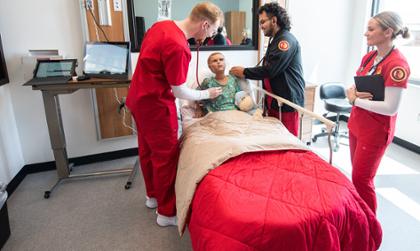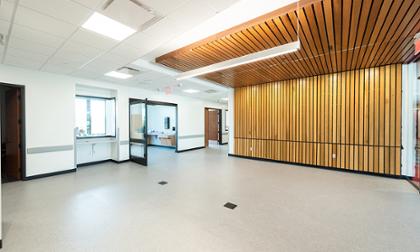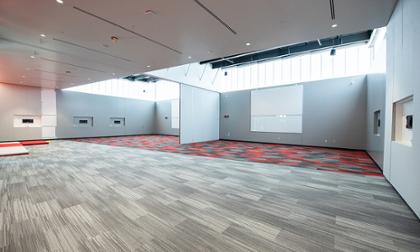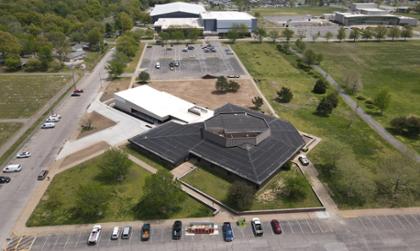On Tuesday, reporters from area media outlets were invited to tour the facility, with faculty and students on hand to point out features they love and to demonstrate the capabilities of one of the new simulated patient rooms.
“I think we get the keys tomorrow,” said Ashleigh Heter, who coordinates the BSN program for juniors and seniors. “We’ve all had tears when we walked in that door and think about what our students will have to learn in, and our faculty will have to teach in.”
The nearly $8 million project is being built by McCownGordon and funded by private gifts initiated by donors. It includes a 10,000-square foot addition to McPherson Hall, home to the nursing school since it was built in 1977, and targeted renovations of approximately 14,000 square feet in McPherson.
“The project is absolutely amazing and is much more than we expected,” said Cheryl Giefer, director of the nursing school. “All of us are very appreciative and we cannot wait to begin using our new space.”
Giefer was a junior nursing student when McPherson Hall was built and recalls taking classes in several buildings on campus. The same is true of this year’s nursing students, who have been scattered between Grubbs Hall, Axe Library, the Garfield Weede Building, and the Kansas Technology Center, since construction began in April 2022.
It’s worth it, they say.
“I’m looking forward to August,” said Junior Alyssa O’Hare, of Kansas City. “It will be a great home — we can study here, practice here, do simulations here.”
Junior Zackary Goswick, of Webb City, Missouri, is excited to use it his senior year.
“It has a hospital feel, so it gives us as close to the real environment as we can get,” he said.
Junior Olivia Chase, of Louisburg, Kansas, said she believes it will take their skills to the next level.
“It’s going to help us feel a lot more confident by the time we graduate,” she said. “It gets me really excited for senior year, and for all those who come after us.”

McPherson Hall was built to accommodate 60 students; in recent years, the nursing school has had cohorts of 90 students. The addition will allow for 120 students and nursing graduates are in demand.
Heter said the purpose of the addition is to give graduates a realistic setting in which to practice skills — and make mistakes — before they begin their careers.
“When they actually do get out into a hospital, they’ll have had experiences that they can draw from,” Heter said.
Part of that experience is with highly technological simulated patients, including a pediatric mannequin that can cough, move, and present symptoms, and a birthing simulator complete with mixed reality goggles to see what’s happening inside the patient — including uterine contractions.
“We’re in a rural community, so some of our graduates will go on to work in small medical centers where there may not be a doctor, and they need to be somewhat knowledgeable about precipitous delivery,” Heter said.
The building includes the simulated hospital rooms, associated control and preparation rooms, debriefing rooms, a waiting area, a nurse’s station, and a study space outfitted with state-of-the-art simulation equipment. The classrooms are flexible spaces outfitted with large monitors so students can see presentations no matter where they’re seated. Carpeting throughout, and into McPherson Hall, lessens noise. Large glass windows allow for natural light.
In the next few months, furnishings, technology, and equipment will be moved in and installed. Classes will begin using the space in August. A ribbon cutting and grand opening will be planned.


Geothermal wells are part of the system that heats and cools the building — the only academic building on campus that is entirely heated and cooled with geothermal. Geothermal energy is considered a renewable resource because it harnesses the earth’s heat.
The white roof on the addition was an intentional decision to reduce heat gain and save on future energy costs.

Students can select programs such as the BSN (Pre-licensure), RN to BSN, MSN (Education Emphasis), MSN to DNP, and the BSN to DNP.
The baccalaureate degree program in Nursing, master’s degree program in Nursing, and Doctor of Nursing Practice are accredited by the Commission on Collegiate Nursing Education.
The bachelor of science in Nursing and Doctor of Nursing Practice programs are approved by the Kansas State Board of Nursing.
Learn more